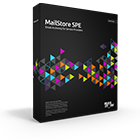Difference between revisions of "Main Page"
| [unchecked revision] | [unchecked revision] |
| Line 22: | Line 22: | ||
{| | {| | ||
| style="vertical-align: top; width: 200px" | [[Installing MailStore Service Provider Edition|Installation]] | | style="vertical-align: top; width: 200px" | [[Installing MailStore Service Provider Edition|Installation]] | ||
| − | | Irrespective of the | + | | Irrespective of the projected scenario, it all begins with the installation of the software itself. |
|- | |- | ||
| [[Single Server Mode Setup|Initial Configuration]] | | [[Single Server Mode Setup|Initial Configuration]] | ||
| − | | Starting with Single Server Mode is | + | | Starting with Single Server Mode is generally a good starting point. Roles can be added or moved to other servers as more and more instances are added to the environment. |
|- | |- | ||
| − | | [[Firewall Configuration]] | + | | [[Firewall Configuration for Single Server Mode]] |
| − | | To | + | | To access the MailStore Service Provider Edition from remote systems, appropriate firewall rules must be set up. |
|} | |} | ||
Revision as of 19:02, 16 March 2017
Service providers receive an unlimited, scalable software solution with MailStore Service Provider Edition, which they will be able to independently operate either on their existing IT infrastructures or those they have leased. This help website has an exclusive focus on installing and setting up the backend of the MailStore Service Provider Edition. The Getting Started section takes service providers through the essential setup and configuration steps and ends with a few important yet optional post-installation tasks.
Getting Started
The following provides a walk-though of the essential steps to get the MailStore Service Provider Edition up and running, including the creation of instances, management of users, and the archiving of email.
Before You Start
| Overview | Familiarize with the architecture of the MailStore Service Provider Edition. The overview also shows the most common and realizable scenarios. |
| System Requirements | Before installing MailStore Service Provider Edition, ensure that the system requirements are met. A requirements calculator helps to determine the needs dependent on the number of users, instances, archiving strategy, and the intended retention period of archived email. |
| Frequently Asked Questions | Checking the FAQ might help to identify potential pitfalls or show stoppers early in the implementation process. |
Installation and Setup
| Installation | Irrespective of the projected scenario, it all begins with the installation of the software itself. |
| Initial Configuration | Starting with Single Server Mode is generally a good starting point. Roles can be added or moved to other servers as more and more instances are added to the environment. |
| Firewall Configuration for Single Server Mode | To access the MailStore Service Provider Edition from remote systems, appropriate firewall rules must be set up. |
Using MailStore Service Provider Edition
| Logging On | The Management Console is the central web-based administrative tool for MailStore Service Provider Edition administrators. |
| Creating Instances | Within a the MailStore Service Provider Edition, every customer gets his own self-contained MailStore instance that runs completely isolated from those belonging to other customers. Before emails can be archived, it is necessary to create such a MailStore instance first. |
| Starting Instances | Before being able to access a newly created instance, it must be started manually. |
| Accessing Instances | A special service provider access to running instances, makes it easy to fully manage instances for customers. |
| End User Access | This article contains information on how to access an instance as the customer administrator if the customer is responsible for the administration of the instance himself. Also information for end users how to access archives email can be found in here. |
| Instance Administration | Get an overview of the functions available inside each individual instance, such as managing users and setting up archiving. |
Post Installation Tasks
| Branding | The MailStore Service Provider Edition comes with a generic service provider branding. Learn more about how to give the MailStore Service Provider Edition a unique look. |
| Replace Self-signed SSL Certificates | For security and end user convenience, it is highly recommended to replace the self-signed SSL certificates of the public facing HTTP, IMAP, and IMAPS services by certificates signed by a trusted root certificate authority. |
| Enhancing SSL Security | The default SSL security settings on most operating systems do not meet the current security industry standards. Learn more about how to enhance the SSL settings on Windows in order to provide your customer the best available security standards. |
| Backup and Restore | |
| Monitoring |
Management ConsoleThe MailStore Management Console is the primary, web based administration utility for MailStore Service Provider Edition administrators. The following articles provide documentation for all available functions. Each function of the Management Console also has a corresponding Management API command, which allows full, script-based control over MailStore Service Provider Edition. |
Management APIThe Management API extends the management capabilities of the MailStore Service Provider Edition by providing a HTTP based access to all management functions. This allows to fully automate the administration of MailStore Service Provider Edition via scripts or even integration into centralized management solutions. For an even faster development, example API libraries for different scripting and programming languages are provided. Example Implementation of API Libraries |
Related Articles |
DownloadsActive Directory Group Policy Templates |
